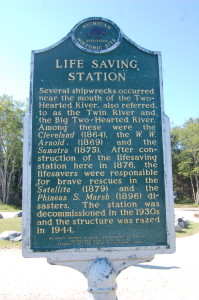
A Trip to Michigan’s Two Hearted River With Bell’s Two Hearted Ale
We first made the trip back to the mouth of Michigan’s Two Hearted River in June of 2012, less than a month after the Duck Lake Fire had devastated much of the surrounding area. The drive back on CR-500, CR-414 and CR-423 took us past charred forest, burned-down cabins and lodges and even a few melted vehicles. Once we reached the campground and parking area for the rivermouth, we ventured out on the suspension bridge and from there we could see just how close the fire had come to Lake Superior. The fire eventually destroyed more than 21,000 acres and many structures, including most of the popular Rainbow Lodge. When we recently returned, it was great to see that the forest has started to come back and the Rainbow Lodge has started to rebuild.
The mouth of the Two Hearted River is located where the river reaches Lake Superior, more than 30 miles from the towns of Newberry (to the south/east) and Paradise (to the east). This is a fairly remote location, which helps keep the natural beauty of the area intact. The Two Hearted River is 24 miles long and considered one of the top trout streams in the country. The area was brought a great deal of fame thanks to the Ernest Hemingway short story “The Big Two-Hearted River,” although he used the name only while actually describing the Fox River near Seney.
A two-sided Michigan historical marker here tells of the life-saving station that once stood here:
Here stood the Two-Hearted River Life Saving Station, built in 1876. This station, like many others on the Great Lakes, was of the second class — erected at a cost of $4,790 and manned by volunteer crews. The facility, a simple two-story building with a small lookout tower, housed a lifeboat and other necessary equipment for recovering endangered sailors. An average crew consisted of six to eight experienced surfmen. In 1915 the Life Saving Service was integrated into the U.S. Coast Guard.
Several shipwrecks occurred near the mouth of the Two-Hearted River, also referred to as the Twin River and the Big Two Hearted River. Among these were the Cleveland (1864), the W. W. Arnold (1869), and the Sumatra(1875). After construction of the life saving station here in 1876, the lifesavers were responsible for brave rescues in the Satellite (1879) and the Phineas S. Marsh (1896) disasters. The station was decommissioned in the 1930s and the structure was razed in 1944.
We returned here in June of 2015, and decided to bring along one of our favorite beer – Bell’s Two Hearted Ale. This beer continues to earn awards as one of the top IPAs in the country, as it has been honored by Zymurgy, Ratebeer.com, Thrillist and others. It is one of our favorites, and its availability in four pack 16 oz. cans makes it a great choice for taking along on vacation.
Great views come from the suspension bridge that crosses the river here, as visitors can see upstream and downstream while also viewing both banks and the open waters of Lake Superior. A state forest campground is also located at the rivermouth, for those looking for a rustic experience away from busier, more populated tourist destinations. There is also a picnic area near the parking lot which is a great place for a quick lunch or a few cold beers.
This was a great trip that really appealed to us as fans of Michigan beer, Michigan history, and the scenic beauty of the Upper Peninsula. The area is worth visiting if you’re looking to see a wilder part of Lake Superior, or if you’re in the area to check out the Crisp Point Lighthouse, Whitefish Point Lighthouse and the Great Lakes Shipwreck Museum or Tahquamenon Falls State Park. From M-123 west of Paradise and northeast of Newberry, take CR-500 north (signed for Crisp Pt.), then turn left on CR-414 and follow it to its intersection with CR-423 (not well marked). Head north on CR-423 and follow it to its end at the campground and parking area.














